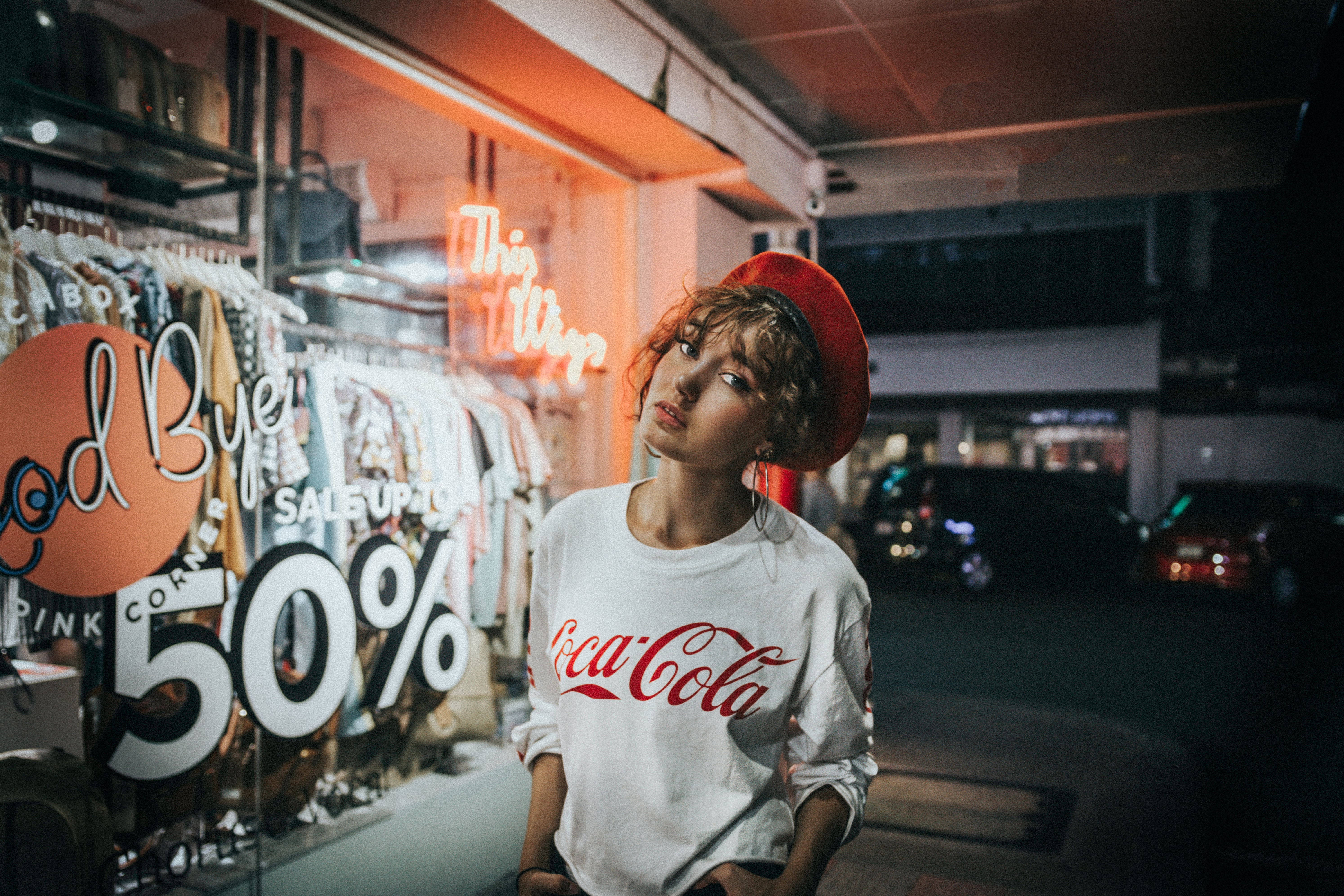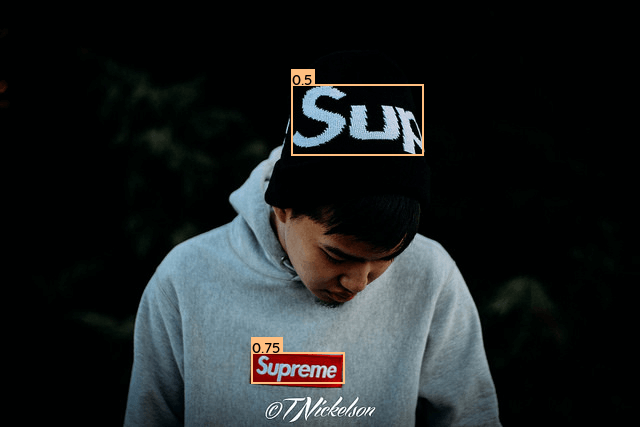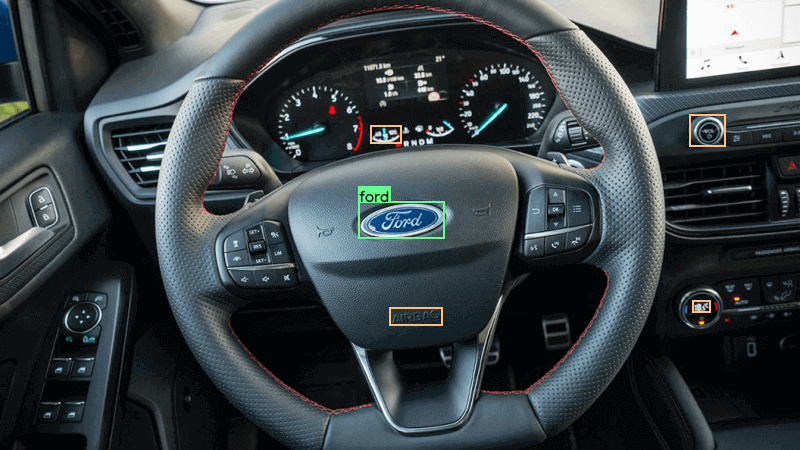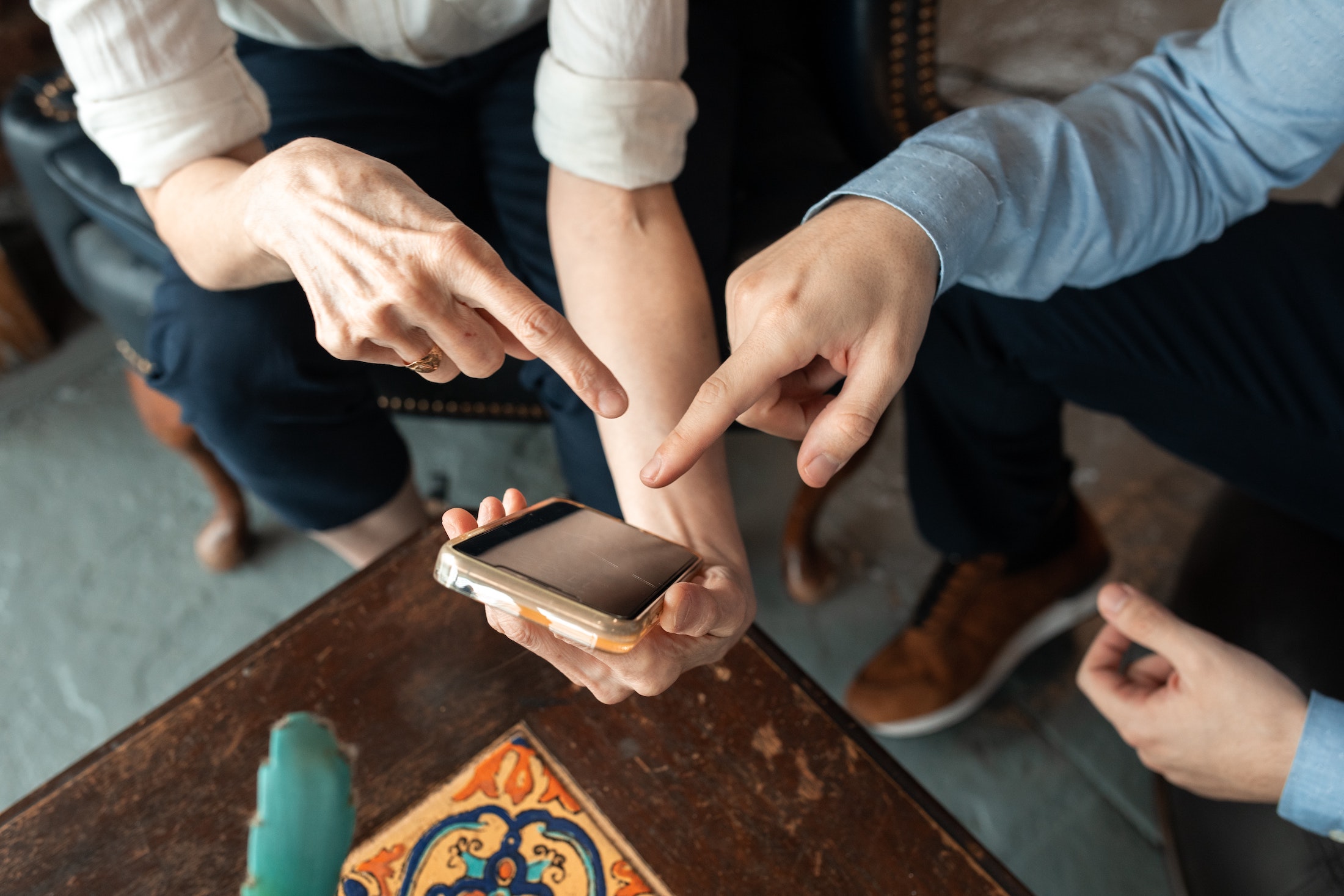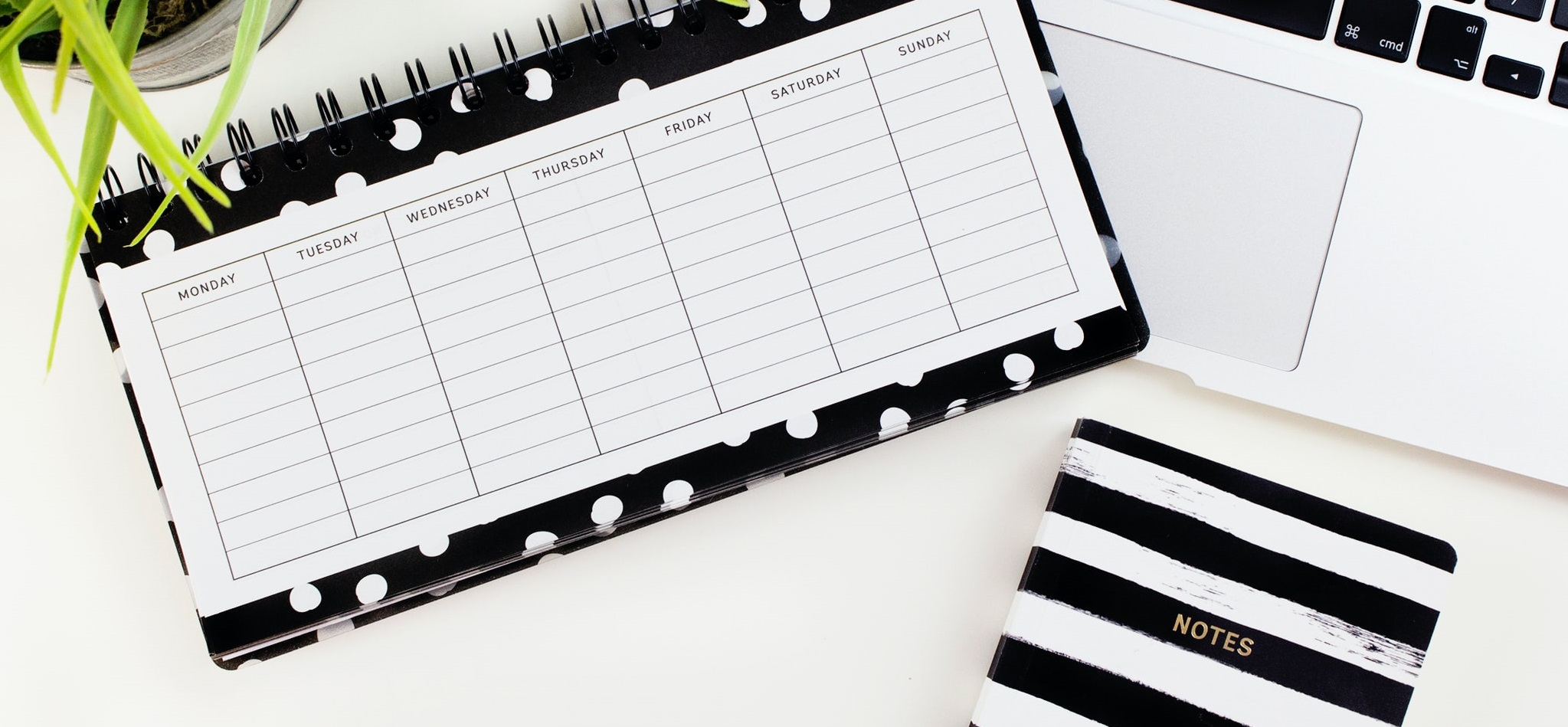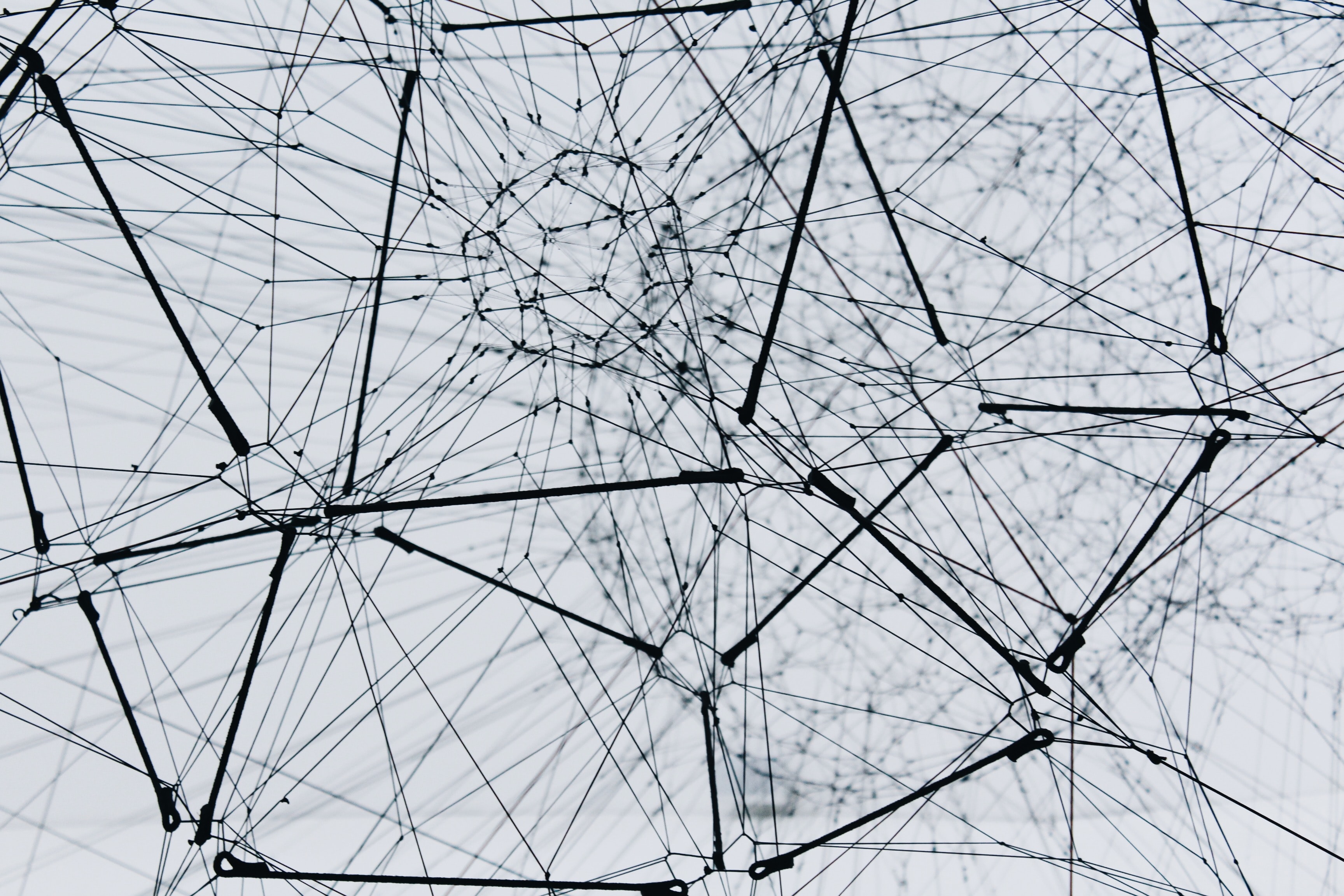Influencers became a hit on social media over the last few years, so it’s not a surprise that so many brands are reaching out to them. Influencer marketing is considered a quick way to increase your brand’s reach, as long as your influencer is relevant to your niche. But if your collaboration appears to be especially promotional, what are the chances that it will negatively impact your brand?
This is what we specifically wanted to check. We analyzed profiles of different content creators to see if their engagement was influenced by logotypes and sponsored hashtags. Through this analysis, we wanted to find out:
- Do posts with or without logotypes have better engagement? What about when they have hashtags indicating a sponsorship?
- How many posts can be categorized as discreetly marketing products (in our case they won’t have logotypes)?
Thanks to our AI models, we gathered hundreds of social media posts and scanned each post for any logotypes. Without these models, it would have been impossible to analyze such a large number of Instagram content creators’ posts in a short amount of time by hand.
And here’s just the beginning of what we found:
- Only two influencers’ engagement was negatively impacted by having logotypes in their posts, the rest of the influencers were not affected,
- Only 40% of posts that were sponsored had logotypes on the picture and only 13.3% of posts with logotypes had a sponsored hashtag.
But there’s much more going on than just that in the article. You’ll have to keep reading to see if your assumptions about influencer marketing and branding are correct. 🙂
Let’s get started!
Why use influencer marketing in the first place?
Although there are still billboards and posters around to advertise a product or service, we should keep it real. Fewer and fewer people are paying attention to these media. From a marketer’s perspective, influencer marketing is a lucrative business. A 2019 survey showed that 89% of marketers thought that ROI from influencer marketing was the same or better than other marketing channels. What about their favorite platform? Instagram, of course!
By getting influencers to mention, review, or promote your products, you’ll get certain recognition that you might not have had otherwise. If this influencer can recommend your product, or give an honest review of it, their audience will probably open your profile and check you out. Consumers are much more likely to purchase products that they know have been endorsed by people they trust, whether that’s an influencer, a specialist, or their own friends.
How can I cooperate with an Influencer to promote my brand?
Influencer marketing on Instagram has gone through many changes. It used to be common to see influencers advertising products without disclosing their partnerships with one brand. This received a lot of criticism over the years, mostly because users weren’t sure if the review or recommendation was genuine.
There are different ways that you can make it clear that content is promotional. Instagram now gives you the option to state that your post is a paid promotion with a brand. Alternatively, other influencers add hashtags such as #sponsored or #paidad to make it clear that they are incentivized to post about the product to their followers.
Recently, the trend of in-your-face logos in posts has died down. Instead, influencers and content creators now post what looks like organic content, but they talk about the product in the caption. The reason why this seems to work is because influencers are able to show the product and what the outcome of using the product can be without being aggressive.
Since companies can be mentioned in all of these different ways, we wanted to know if these strategies are have any impact at all on engagement. Would it be logotypes that would make an impact? Hashtags denoting sponsorships? Or some combination of both?
By the way, you can get definitive answers about which influencers would be good brand ambassadors through a specially prepared Instagram report. The Instagram Comparison report can tell you more about which profile gets the most engagement, which content performed best, and which hashtags would be best for future campaigns, to name just a few questions you’ll get answers to.
So now, let’s go over why you should be analyzing logotypes in the first place.
Does content featuring brands and sponsorships result in lower engagement?
Whether you decide to use a logo in a deal with an influencer is ultimately up to you, but you’ll want to know what type of promotion would be best for your company. Sponsored content could get less engagement if the post is too promotional and not genuine, so it’s good to work with an influencer who would be honest about their opinion. If you’re set on a specific influencer, you could find out whether their audience would be more interested in posts with or without the logotypes included in the images.
What’s more, this could help brands adapt their own Instagram content. If you manage to see a decline in engagement whenever you include excessive logos, then it’s a sign that you should cut down to increase customer interest. Your followers will get more value out of your content because it also won’t be just another ad in their feed.
Comparison of all influencers across different analyses
First of all, how did we choose influencers for our analysis? Essentially, we looked for influencers and content creators who tend to review or recommend certain products or services. They generally posted content at similar rates within 90 days, had a mix of interesting promotional and organic content on their profile, and were between micro and macro level influencers.
Many of the influencers we’ve analyzed are known for a certain skill set or other interests than being hyper-focused on being your brand ambassador. For example, although @sweetpotatosoul cooks, she also promotes other food items, since most of her followers are there for her and the food. Makes sense so far, right?
We divided the profiles into a few different categories so that we could show you the results across different niches. We had:
- three profiles whose primary focus was food,
- two profiles that focused on beauty,
- one that focused almost solely on fashion,
- at least three profiles that posted lifestyle content,
- and two that posted about travel.
Though keep in mind, some of these influencers overlapped with each other, and did not exclusively post about one topic.
You can see the full table below to see the different analyses and results we gathered.
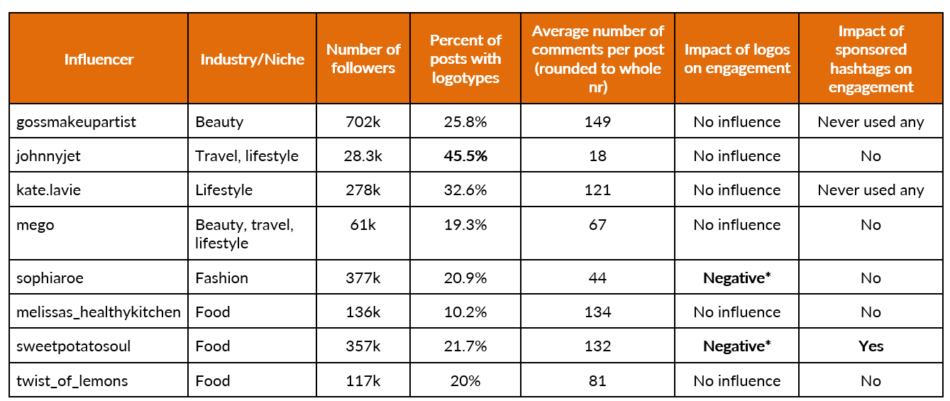
Note: the asterisk (*) denotes that our statistical tests showed that our comparisons were significant, and that logotypes had a noticeable influence on engagement.
Do posts with or without logotypes have better engagement?
Most of these profiles weren’t affected by the use of logotypes. However, it looks like only two profiles had significantly less engagement when they used logotypes in their posts. Specifically, this was the case for @sophiaroe and @sweetpotatosoul.
In general, the presence of logotypes didn’t affect the engagement going on under the posts, except in the case of two influencers. It is interesting that even though @johnnyjet had almost twice as many logotypes in his posts than @sophiaroe or @sweetpotatosoul, he wasn’t negatively impacted like they were.
One possible explanation could be that their followers follow them to see a finished look (for @sophiaroe) or to see perfectly cooked meals with recipes underneath, and not any specific brands. Although high fashion brands are a big deal in fashion, @sophiaroe’s posts are usually scenic and photogenic, and generally have her tagging a brand rather than wearing explicitly logo branded clothing like other celebrities. This could have been part of her charm and reason why her fans follow her to begin with.
Alternatively, we should always consider that some other influencers out there might be getting spammed engagement or interactions that were paid for. Therefore, it might look like the number of logotypes or the promotional nature of the post might have resulted in better engagement than it actually did.
How many posts are actually sponsored but don’t have logotypes in them?
One of the questions we wanted to answer was whether the number of logotypes and promotional hashtags present was going to be proportionate or not. This type of analysis hasn’t been performed in a practical way by marketers, so we decided to be the first to start answering these questions. 😉 Marketers are interested in analytics, but they don’t tend to perform statistical analysis to verify all of their results. In this article, we’ll be putting statistical testing to use to be able to draw conclusions based on our selected influencers data.
We calculated how many of the posts that the AI examined for us had a logotype, a hashtag, both or neither present. This allows us to draw conclusions about the practices of these influencers.
We need to point out that there were definitely many posts that appeared to be promotional, but did not use hashtags that indicated that they were promotions. For example, @gossmakeupartist was promoting and discussing his branded products, but because he was not being paid by another party to advertise it, he did not include those hashtags. We did not include such posts in the “promotional hashtag” category for this reason.
Distributions of promotional hashtags and number of logotypes for all influencer posts
- Only 6.8% had sponsored hashtags out of all of the posts we analyzed
- Almost 20% of the posts that aren’t hashtagged as sponsored still had logotypes
- Even though most posts didn’t have a logotype, 5% of those without a logotype actually had a sponsored hashtag
- Close to 80% of all posts didn’t have any logotypes
These findings tell us so much about the data. First of all, almost 41% of the posts that were ads ended up having a logotype in the picture. This means that close to 60% of sponsored content didn’t even include a brand’s logo, but showed off the results instead of the products themselves. This could be that discrete marketing we mentioned to you earlier, about promotions not being as obvious or ad-like. Meanwhile, out of all posts with a logotype, a massive 86.7% couldn’t be counted as ads because the influencer didn’t add the right hashtag. This means that you could be missing data while only analyzing hashtags, and why you should analyze posts semantically, including images.
Thanks to the AI model, we were able to detect logotypes in images. Without it, these findings above couldn’t have been analyzed without the data, because let’s keep it real, who has the time to look through all of those posts? We wouldn’t have been able to measure the marketing impact of logos without it.
Do posts with more sponsorship related hashtags get more engagement than those without these hashtags?
To answer this question, we used the same test as for logotypes. Since neither @katie.lavie nor @gossmakeupartist used promotional hashtags in their posts, we could not analyze them.
In general, there’s no difference in engagement between posts with or without sponsorship related hashtags. Only one profile (@sweetpotatosoul) had less comments when she had promotional hashtags. The AI indicated that the @sweetpotatosoul profile had more posts with no hashtags and no logotypes than expected, and she had slightly fewer posts that had hashtags but no logotypes present. Other than that, the rest of her results appeared to be in the expected range.
Looking back at the previous results, we saw that she had less logotypes than some others. That might sound surprising, but this really shows us that it’s about the “fit” of the audience and the products being promoted. Luckily, our AI model managed to detect the worst posts in terms of engagement and we further analyzed the content.
So here’s what might have gone wrong for a profile like @sweetpotatosoul’s.
View this post on InstagramHappy National Coffee Day! #ad I quit drinking coffee when I was pregnant, and since then, I never adopted my daily habit back. And let me say, coffee is even better and more special when you don’t drink it everyday. On the other hand, @theoatyeah creamer has me considering starting up the habit again. It’s so yummy! I used @theoatyeah Oatmeal Cookie creamer to make a coffee cake with an oat streusel topping and enjoyed that with my first cup of coffee in many months. Topped with the Oatmeal Cookie creamer, of course ? . IMO plant-based creamers are now better than dairy ones. So if fear of quitting your favorite dairy-based creamer has stopped you from becoming vegan, it’s time to let that go, my friend!A post shared by Jenné Claiborne (@sweetpotatosoul) on
Here, she is obviously promoting something that was ready made, and that she didn’t need to get creative with. But let’s compare that to her usual posts…
View this post on InstagramTempeh Tikka Masala is perfect for any time of year. I just made it in the Instant Pot for lunch, and now I feel so nourished and happy ? It calls for vegan yogurt, but I didn’t have any, so I used more coconut milk ? Perfection! Link to the recipe is in my bio! #veganrecipes #sweetpotato https://sweetpotatosoul.com/2018/12/tempeh-tikka-masala-easy-instant-pot.htmlA post shared by Jenné Claiborne (@sweetpotatosoul) on
This is what a typical post looks like for @sweetpotatosoul. She usually posts a picture of a finished meal along with the recipe underneath. From time to time, she’ll post a picture of herself or her child. It’s possible that her audience just doesn’t care so much about sponsorships and recommendations, but her actual ability to create great food.
But how can we summarize the content she posted?
- 78.3% of all her posts had 0 logotypes, and 21.7% had 1 or more
- 28.3% of her posts featured a promotional hashtag, so at least this amount of posts were purely promotional.
The impact seems to be mostly neutral when you look at our influencers overall, so it is still worth trying to use logotypes. As brands that want to include influencers in your marketing campaigns, you should keep track of how an individual influencer’s engagement changes with the presence of logotypes. Still, to draw such a conclusion, you might want to compare whether your engagement has changed by comparing posts with and without promotional content every so often. Even if you don’t have promotional hashtags present, you can still have an analysis instantly performed to detect logotypes to draw conclusions. 😉
How did we detect logos? An explanation of Sotrender’s logotype detection model
First of all, why do you need to use machine learning to simplify this task? The easy answer is that it’s time saving. By using a logotype detection model, it cuts the amount of hours you would otherwise spend on looking at every profile’s pictures and label it as having a logotype or not. The overall benefit of using these models in general is that you can track how often brands and products appear in visual content on social media. That way, you can analyze how often you versus your competition end up getting seen on social media, and who is coming out on top.
Sotrender’s logotype detection model can be used to analyze the frequency of logotype use, placement, and size. It can also generate metadata for social media images, which can then be used in another machine learning model (e.g. popularity prediction model).
The logotype detection model we use is made up of two parts: the universal logo detector (trained using the Logos in the Wild dataset) and the descriptor generator. To simplify things, the structure of our system looks like this:
In the first step, the image goes through the universal logo detector, which then generates bounding frames that will define the locations for potential logos. The descriptor generator describes the new, cut up images (where the logos could be located) with number vectors. They get classified by comparing descriptors of potential logos with a brand reference descriptor. The gist of it is that this model looks for similar descriptors for similar images, and different descriptors for different images so it can classify them accurately. You can see how it works with real images like this one:
And how it can recognize the logotypes as belonging to a specific brand like this:
This is a very short and simplified summary of how we can get it done.
Subtle advertising, or going all in?
So as you can see, posts that featured logotypes had similar engagement for most influencers as those without logotypes.
If you’ve done your research on a specific influencer and find that their performance meets what your standards, it’s probably the case that including branding in their posts won’t have a negative impact. That way, evaluating your potential campaign reach, engagement, and views will also be straightforward.
Promotional hashtags didn’t make much of a difference for our influencers in terms of engagement, except in the case of a contest or giveaway. If you’re planning on running a contest, consider using some type of hashtag so that you can easily compare the engagement and reach of the post to determine whether the contest was a success or not. However, we are creating new opportunities that make it so much easier with image recognition. Hashtags used to be a must, but analyzing your campaign and content will be easier with an AI model.
We have two pieces of advice for you here. Firstly, come up with a list of influencers who could represent your brand. We can help you with analyzing them with our Instagram Comparison report and decide on the best influencer for your brand.
Once you start cooperating, monitor engagement over time under the influencer’s posts. If the engagement, especially under sponsored content, declined, brainstorm what could be changed or improved. Maybe your logotype was shown too many times and the promotional content could be more subtle? Maybe there was no healthy balance between promotional and organic content on the influencers profile? Think about all these aspects before continuing your collaboration. After all, no one wants to waste money on promotion, but the influencer should also care about their followers and staying trustworthy.
Remember, most posts don’t have logotypes as the center of attention. It might be better for your brand to show off the benefits of using your products or services. As some experts say in-your-face advertising is over, and organic, helpful, and insightful content is in. As long as you or your brand ambassadors are providing value to your followers, it’s the first step to raise interest in your brand.
If the brand or product is completely unrelated to the influencer, then you have wasted both your resources and their followers’ time. Influencer marketing is important, but you should always try to find the best match between your company, your audience, and the influencer.
